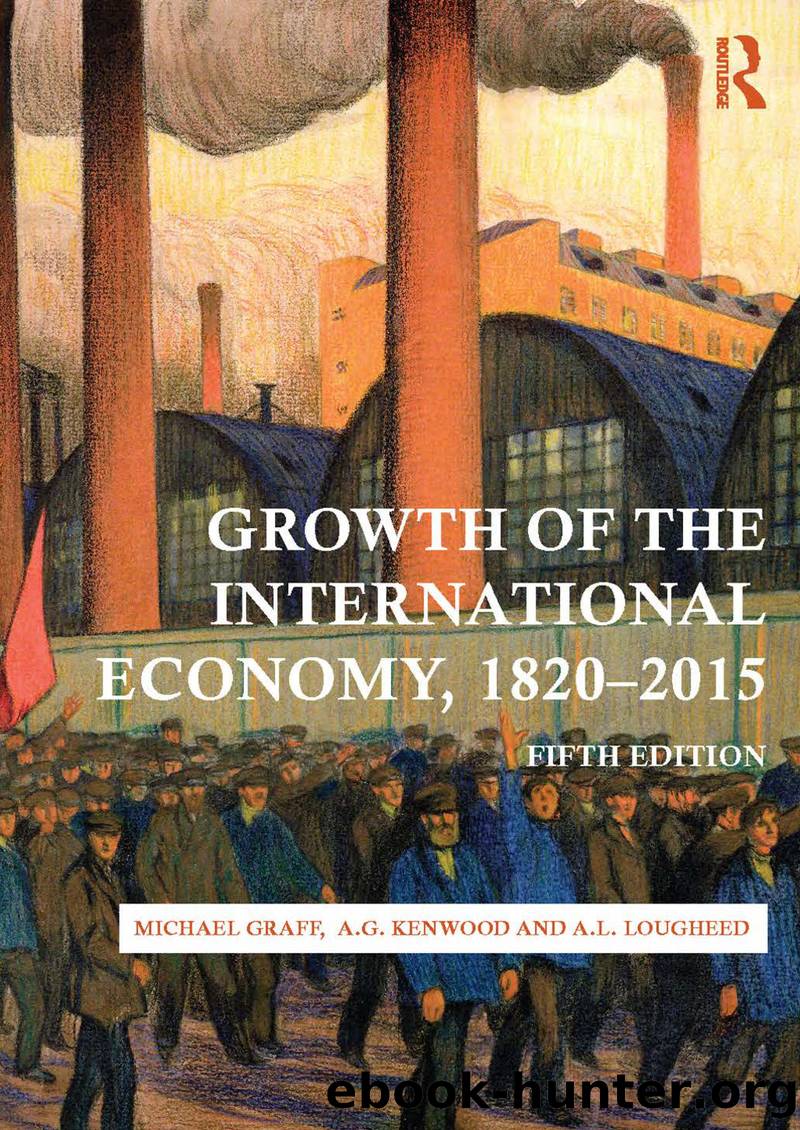Growth of the International Economy, 1820-2015 by Michael Graff

Author:Michael Graff
Language: eng
Format: epub
ISBN: 9781135010645
Publisher: Taylor and Francis
Published: 2014-06-15T00:00:00+00:00
The Economic Boom of the Late 1920s
Despite its weaknesses, the restoration of the gold standard marked the beginning of a major industrial boom centred on Europe. After the economic collapse of 1920â1 and up to 1925, Europe suffered a relative decline in its economic standing in the world. Whereas European production did not regain pre-war levels until 1925, it increased by 20 per cent between 1913 and 1925 in Asia and Oceania, by 25 per cent in North America, and by even more in Latin America and Africa. But with the general improvements in economic and political conditions on the continent following the stabilization of inflated currencies and the settlement of the war debts, the stage was set for rapid economic development. Over the next five years the world experienced a construction boom based largely on the need for re-equipping the European countries. In the period after 1925, therefore, growth was much more vigorous in Europe than in the other continents.
The expansion of production that took place in the first post-war decade affected all sectors of the world economy. Food production increased by 10 per cent between 1913 and 1925, and grew by another 5 per cent by 1929 when compared with 1925. Over the same two periods, the production of raw materials grew by 25 per cent and 20 per cent, respectively, the much higher rate of growth in the latter period as compared with that for foodstuffs being the result of the high level of demand for raw materials generated by the European boom. In manufacturing, there was rapid growth in iron and steel production, engineering and motor car manufacture during these years. Shipbuilding was running at a high level, with motor ships increasing as a proportion of total output from 14 per cent in 1923 to 44 per cent in 1929. The output of heavy chemicals grew by one-third. Textile production expanded rapidly in Japan and certain other newly industrializing countries, but stagnated in Europe, although the output of artificial silk rose by 133 per cent between 1925 and 1929.
By the end of 1929, however, there was much evidence that the boom had passed its peak. Stocks were accumulating and there was considerable surplus capacity evident in manufacturing production. The spread of commodity control schemes indicated the growing difficulties of primary producers. Indeed, in North and South America and in Oceania the peak of productive activity had been reached in 1928. To the effect of accumulating surpluses was added another adverse element â a tendency for imports of capital into these countries to decline. But it was when the outflow of gold from the US reversed its direction as a result of the Wall Street boom that the true nature of the flaws in the international economy stood fully revealed.
Download
This site does not store any files on its server. We only index and link to content provided by other sites. Please contact the content providers to delete copyright contents if any and email us, we'll remove relevant links or contents immediately.
| Accounting | Economics |
| Exports & Imports | Foreign Exchange |
| Global Marketing | Globalization |
| Islamic Banking & Finance |
50 Economics Classics by Tom Butler-Bowdon(2072)
Six Billion Shoppers by Porter Erisman(2003)
Why Nations Fail: The Origins of Power, Prosperity, and Poverty by Daron Acemoglu & James Robinson(1791)
No Time to Say Goodbye(1766)
The Economist [T6, 22 Thg9 2017] by The Economist(1646)
Red Notice by Bill Browder(1598)
Currency Trading For Dummies by Brian Dolan(1552)
Thank You for Being Late by Thomas L. Friedman(1458)
Bitcoin: The Ultimate Guide to the World of Bitcoin, Bitcoin Mining, Bitcoin Investing, Blockchain Technology, Cryptocurrency (2nd Edition) by Ikuya Takashima(1423)
Amazon FBA: Amazon FBA Blackbook: Everything You Need To Know to Start Your Amazon Business Empire (Amazon Empire, FBA Mastery) by John Fisher(1307)
The Great Economists by Linda Yueh(1186)
Coffee: From Bean to Barista by Robert W. Thurston(1186)
The Future Is Asian by Parag Khanna(1174)
Pocket World in Figures 2018 by The Economist(1157)
Capitalism Without Capital: The Rise of the Intangible Economy by Jonathan Haskel(1130)
Grave New World by Stephen D. King(1111)
How Money Got Free: Bitcoin and the Fight for the Future of Finance by Brian Patrick Eha(1107)
The Sex Business by Economist(1088)
Cultural Intelligence by David C. Thomas(1013)
